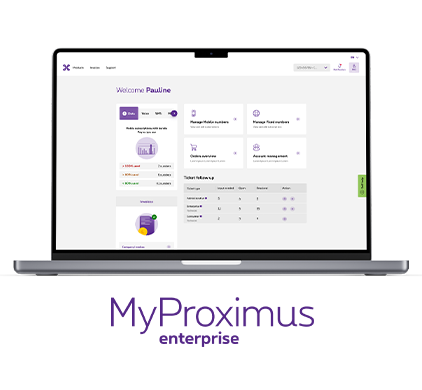Wilkommen
Stärken Sie Ihre Resilienz mit smarter Datennutzung
Proximus NXT hilft Großunternehmen, ihre gesamte Data Lifecycle unter Kontrolle zu bringen
Daten spielen eine entscheidende Rolle in Unternehmen und wachsen schneller denn je. Trotzdem bleiben sie oft fragmentiert, anfällig oder ungenutzt. Bei Proximus NXT gehen wir über reine Telekommunikation hinaus und unterstützen große Unternehmen bei der sicheren und intelligenten Verwaltung des gesamten Data Lifecycles. Von Cloud bis Cybersecurity, KI, fortschrittliche Netzwerke und digitale Arbeitsplätze: Wir vereinfachen ICT-Komplexität, damit Ihr Unternehmen mit Vertrauen voranschreiten kann.
Bereit, das volle Potenzial Ihrer Daten zu entfalten?
Unsere Lösungen helfen großen Unternehmen, Daten in Business Value zu verwandeln
Lösungen
Lerne Sie die aktuellen Angebote für Fest- und Mobiltelefonie, sowie unsere Internet, Explore und End-to-End-ICT Produkte kennen.
Hilfe und Unterstützung
Hier finden Sie die Antworten auf alle Ihre Fragen sowie allerlei Anleitungen.
Wie wir strategische Prioritäten in konkrete Ergebnisse verwandeln
Bevor wir Lösungen empfehlen, stimmen wir unseren Ansatz auf Ihre Ziele ab. Transformation beginnt mit einem tiefen Verständnis Ihres Unternehmenskontexts und wird dann zu skalierbarem Handeln. So gehen wir vor:
-
Discovery phase
Wir analysieren Ihre operativen Herausforderungen, strategischen Ziele und Prioritäten.
-
Assessment
Wir definieren die passende Lösung und Architektur, maßgeschneidert auf Ihre Situation.
-
Implementation
Wir setzen Ihre Roadmap um: sicher, effizient und in Ihrem Tempo.
Why Proximus NXT?
Inspired by tech, driven by people
Warum Proximus NXT?
Sie suchen einen ICT-Partner, der Ihre strategischen Herausforderungen versteht, Ihr Potenzial erkennt und nachhaltige Unterstützung bietet. Genau das können Sie von Proximus NXT erwarten.
Bereit für die Zukunft
Unsere sichere, skalierbare Infrastruktur hilft Ihnen, die Kraft Ihrer Daten in Wettbewerbsvorteile zu verwandeln.
Ein ganzheitlicher Ansatz
Von der Strategie bis zur Umsetzung begleiten wir Ihre digitale Transformation umfassend.
Verankert in der Benelux
Unsere starke lokale Präsenz und Datensouveränität bieten Ihnen Zuverlässigkeit, Kontrolle und Nähe.
Menschenzentrierter Ansatz
Unsere Experten begleiten Ihre Digitalisierung, damit Sie sich auf Ihr Kerngeschäft konzentrieren können.
Offene Partner-Ökosysteme
Wir arbeiten mit globalen Marktführern zusammen und bringen Ihnen Innovation, ohne Vendor Lock-in.
Operative Effizienz beginnt mit MyProximus Enterprise
Strategische Ausrichtung ist entscheidend, aber operative Effizienz ist ebenso wichtig. MyProximus Enterprise bietet Ihnen eine sichere, zentrale Plattform zur Verwaltung all Ihrer Telekommunikations- und ICT-Dienste, einschließlich Produktübersichten, Verbrauch, Rechnungen und direktem Experten-Support.
Wir arbeiten mit starken Partnern zusammen
Lassen Sie sich nicht von Komplexität bremsen
Untätigkeit im Umgang mit Daten hat ihren Preis. Wenn Systeme blockieren oder nicht skalieren können, verliert Ihr Unternehmen wertvolle Zeit, Vertrauen und Widerstandsfähigkeit. Lassen Sie uns gemeinsam angehen, was Ihr Unternehmen zurückhält, mit Lösungen, die Sie voranbringen.



